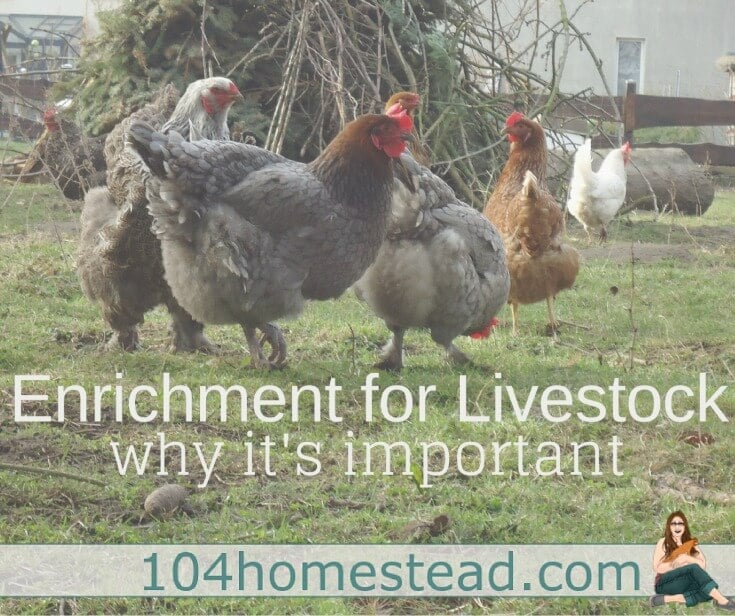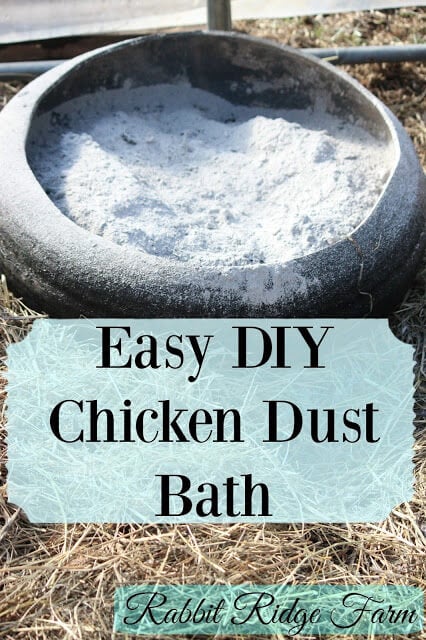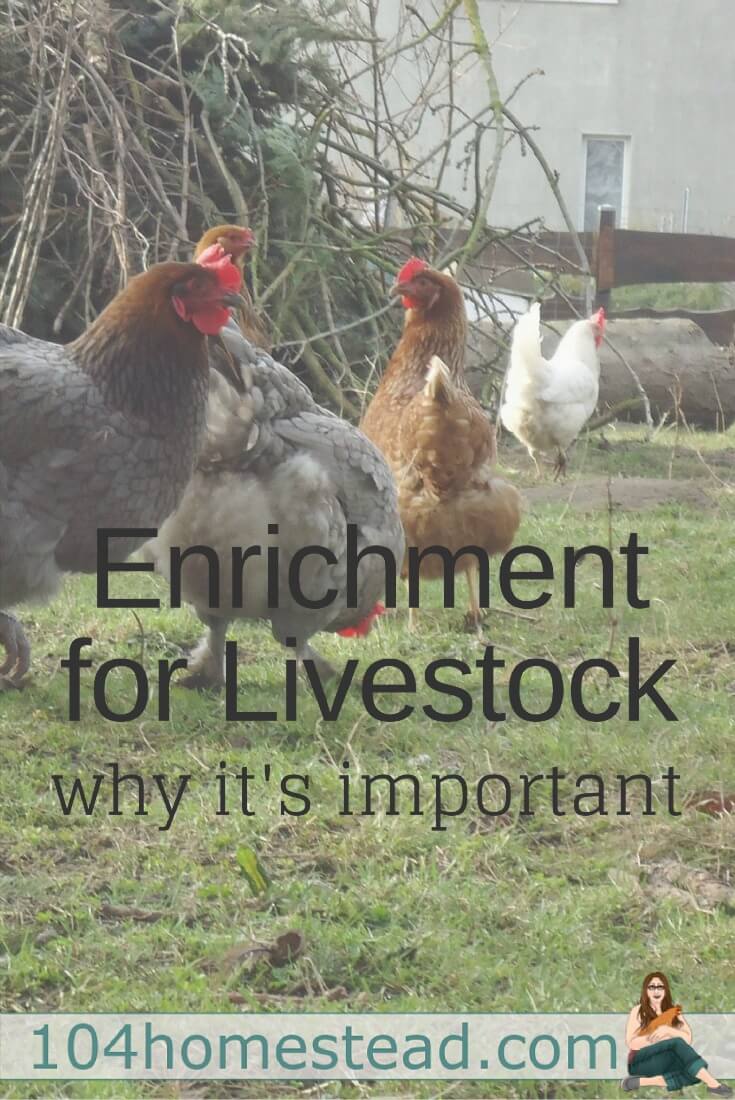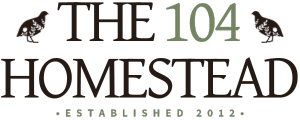What is Enrichment? How It’s Important for Livestock
Animal enrichment is activities that create a more stimulating environment for the animals and elicit some of their natural behaviors.

Today, you are getting Zoologist Jessica instead of Homesteader Jessica. For those of you who don’t know, I went to school for zoology but decided that I didn’t want to live in a city, which is what led me to farming. One important aspect of animal care they taught me about in college was animal enrichment and how important it is to an animal’s health and overall well-being.
Animal enrichment is activities that create a more stimulating environment for the animals and elicit some of their natural behaviors such as exploration, foraging, locomotion, social interaction, manipulating objects, or simply playing.
Enrichment for Goats
The Importance of a Herd
Let’s start with the fact that goats are herd animals. Being part of a herd makes the goat feel safe and secure. As prey animals, this safety and security is paramount to their mental well-being. Making sure your goat is part of a herd (at least one friend, but the more, the merrier) will provide loads of enrichment for your goat just through herd interaction.
Goats are incredibly intelligent and curious. This is a positive trait that is often viewed as a negative because it is learning how to escape. Goats can figure out goat latches, they can find holes and gaps in the fence and even make them large enough to escape, and they can climb almost anything. If you are not challenging your goat’s mind, they will escape. Challenging their mind doesn’t mean you need to build a fortress around your goats. Give them something more exciting to try to figure out.
Climbing and Exploring
Climbing is one of a goat’s favorite things to do. Instead of having them try to climb the fence all day (which will wear out your fence real fast – ask me how I know), give them a jungle gym. It doesn’t have to cost much, and it doesn’t have to be elaborate. We started with a wooden picnic table and slowly added “junk” to it over time. The goats love climbing over and under the different materials. Here’s a trick I came up with that is unrelated but worth mentioning: Top your wooden climbing toys with roofing shingles. The rough surface files down hooves, so you don’t have to trim as often.
Another thing goats enjoy is problem-solving. While you may not want them to solve the puzzle of the gate latch, give them another puzzle to solve. Cause-and-effect games are great for goats. You can incorporate climbing, like with a seesaw, or doing something stationary, like providing a treat ball.
Remember, a healthy goat is an active goat. It is important to provide ample opportunity for exercise mentally and physically.
Enrichment for Chickens, Ducks, and Quail
Having a Flock Family
Much like goats, friends and family are important to poultry in the form of a flock. Flock interaction accounts for much of a bird’s enrichment needs. But that’s not all they need. Poultry that is not adequately enriched will display many problem behaviors such as feather picking, bullying, and even egg eating.
In the ideal situation, your chickens, ducks, and quail would be allowed to free range in a large area where they can explore, forage, and interact. For many of us, that’s not an option. If you cannot free-range your chickens because of space or predator issues, it is your responsibility to provide enrichment. The good news is that many of your daily routines are a starting point for enrichment. You are already going in to collect eggs. While you’re there, you should move something. It’s amazing how something as simple as moving a stall rake can excite your poultry.
Composting with Poultry
Composting in your poultry run is a great form of enrichment. Not only do they get to dig for all sorts of goodies, but they are also getting a varied diet. Quail can’t necessarily have a full-fledged compost bin in their enclosure, but they appreciate kitchen scraps. For important information about what can and cannot be composted with chickens, see here. The best part of composting with chickens is how quickly they break down a compost pile. It’s truly impressive, and my green thumb appreciates it.
Multi-Purpose Dust Baths
Dust baths are another important multi-aspect enrichment for poultry (less for ducks, but a huge win for chickens and quail). Not only do quail and chickens enjoy digging and cooling themselves off on a hot day, but dust baths clean the birds as well. To boost the cleaning and bug-removing properties of your dust bath, mix in a little diatomaceous earth and wood ash. Just make sure if you add wood ash, it’s in a dry location because water makes the ash caustic.

Kiddies Pools for All Fowl
Kiddie pools aren’t just for ducks, though deep ones should only be accessible to waterfowl. My ducks love their kiddie pool when it’s clean and full. They swim and splash and play. I noticed when the pool would get shallow (because of the ducks’ maniacal splashing), the chickens would stand in it on hot days. I offered the quail a small dish, and they did the same. They love it.
Enrichment for Rabbits
Rabbits are also not solitary creatures. Are you catching on to the pattern here? Humans are wonderful, but they are not a substitute for a companion. Rabbit’s lives can be summed up in three simple things: dig, tunnel, and chew. If you provide enrichment opportunities that cover these three areas, you are good to go. If your rabbit is contained in a tractor or allowed to free-range, it has ample opportunity to explore and behave normally. Again, this isn’t an option for most people.
Digging Opportunities
This one is super simple. Find a container and fill it with stuff. The container can be a shoe box, the shipping box from your latest Amazon purchase, a paper bag, or anything else that isn’t harmful when chewed and possibly consumed. Filler can be hay, soil, grass, shredded paper, or small branches. You can even hide treats in the filler to make it even more exciting for your rabbits.
Tunneling Ideas
Tunneling is much like digging. Find a container that is safe when chewed and make holes in it for the rabbit to climb through. Plastic tubes can be really fun. Just make sure your bunny isn’t going to get trapped inside. Flower pots that are tilted slightly are really exciting to rabbits. Just make sure it won’t fall and trap the animal. With a little imagination, you can create an entire obstacle course.
Chewing Choices
The rabbit will most likely chew anything you put in its enclosure (hence the importance of choosing chew-safe containers). Some things are particularly good for your bunny to chew. The list is honestly never-ending, but here are some ideas to get you started:
- Pine cones
- Untreated wicker baskets
- Blocks of wood
- Phone books with shiny covers removed
- Whisk brooms made from straw
- Boxes of all sizes
- Willow twig balls
- Ragdolls
If allowed to chew on it, your rabbit will. The possibilities are endless.
Basic Care Isn’t Really Enough
There are hundreds of sites on the internet that have lists of what your livestock needs. They all sum it up as food, water, shelter, and maybe some medications in case of emergency. As a zoologist, I have to tell you, that’s not enough. Many livestock animals are not suited to being house pets. They belong outdoors. If you are bringing an animal indoors (any animal from goldfish to potbelly pig), it is even more important that you enrich that animal’s life. Food, water, and shelter might keep the animal alive, but what kind of life is it?
Some toys we have on our homestead for the livestock are Precision Pet Chicken Treat Ball, Peter’s Woven Grass Play Ball for Rabbits, and Jolly Pets Tug-n-Toss Chew Ball.
Share your best ideas in the comments below.

